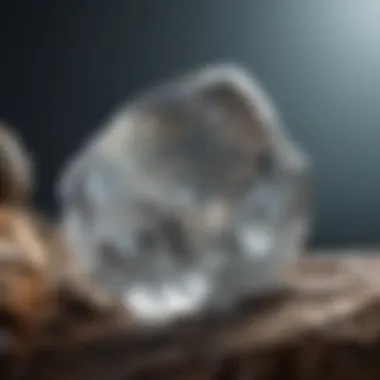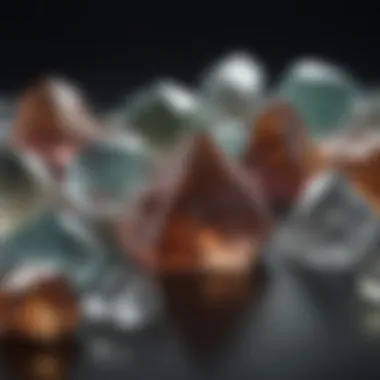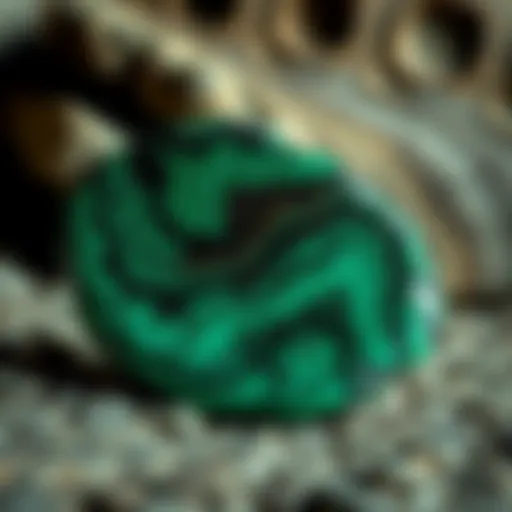Mastering the Art of Crystal Stone Identification


Intro
Crystals and minerals have fascinated humanity for centuries. Beyond their aesthetic charm, these geological wonders tell stories of ancient earth processes, cultural significance, and metaphysical beliefs. Understanding how to identify and classify these stones is not just a practical skill for collectors, but a doorway into the deeper meanings and histories they hold. This guide aims to provide a complete toolkit for anyone interested in the world of crystals and stones, detailing techniques, tips, and insights for both novice and seasoned enthusiasts.
History and Origins
The fascination with crystals is not a modern phenomenon. Cultures throughout history have revered these formations for their beauty, utility, and purported mystical qualities. From the Egyptians who adorned their tombs with lapis lazuli, believing in its protective powers, to the ancient Chinese using jade as a symbol of virtue and morality, crystal stones have left an indelible mark on humanity's cultural landscape.
Overview of Collectibles, Rocks, and Fossils
The world of collectibles is vast, with rocks and fossils forming a significant subset due to their historical and scientific values. Collectors often delve into the intricate details of geological formations, seeking to understand not only their physical attributes but also their implications on natural history. Crystals, in particular, are prized not only for their beauty but for their unique properties—each stone precisely reflecting the conditions of its formation.
Historical Significance and Cultural Impact
From ancient rituals to modern-day healing practices, the importance of crystals transcends mere aesthetic enjoyment. Each culture integrates these stones into its art, medicine, and spirituality, acknowledging their seemingly powerful impacts. For instance, in traditional Indian culture, gemstones were believed to correlate with the planetary system, influencing everything from personal fortunes to health.
"A crystal is like a metaphor for the key: it can unlock deeper understanding and inner peace."
Identification and Classification
Identifying crystal stones requires both observation and intuition. It means looking beyond mere visuals to grasp the elements that distinguish one stone from another. In practical terms, having a systematic approach can simplify the complexities of this endeavor greatly.
Guide to Identifying Rocks and Fossils
When it comes to identifying rocks and fossils, several aspects come into play. Key characteristics to take note of include:
- Color: While it may seem like a basic feature, the color can provide initial guidance in identification.
- Clarity: Some stones are transparent, while others are opaque, which affects their classification.
- Texture: The feel and look of the surface can indicate a lot about formation processes.
- Hardness: Using Mohs scale can help gauge mineral hardness, essential for distinguishing between stones.
- Luster: The way light reflects off a crystal is crucial—whether it is glassy, metallic, or dull can help narrow down identification.
Common Types and Variations
Within the realm of crystals, variety is the spice of life. Some of the prevalent types include:
- Quartz: Often utilized for its versatility, quartz comes in numerous variations, including amethyst and citrine.
- Jade: Known for its significance in Eastern cultures, jade holds a dual meaning as both a gemstone and a symbol of virtue.
- Obsidian: A natural volcanic glass, obsidian is sought after for both its historical use as tools and its place in contemporary jewelry.
Recognizing these distinct types can enhance not just identification skills but also appreciation for the natural world.
Understanding Crystal Stones
Crystal stones hold a captivating allure for many, especially for those who have a sincere interest in nature’s artistry. This section serves as a foundation for the entire guide, ensuring that readers grasp the essence of what crystal stones truly are and why their identification is not just a filler hobby, but an essential skill for any collector.
Definition of Crystal Stones
Crystal stones are naturally occurring solid substances that are formed through the process of crystallization. This involves the arrangement of atoms in a structured pattern, leading to the formation of distinct shapes, each with its own unique characteristics. From shimmering quartz to vibrant amethyst, these stones differ vastly in terms of color, clarity, and hardness. They can occur in various geological formations, each offering hints about their origin and history.
Many might wonder about the term "crystal" itself. It derives from the Greek word "kristallos," which means ice. This hints at the transparent nature of some crystals and showcases humanity's long-standing fascination with these materials. Understanding the definition is critical as it provides context to the subsequent identification methods; knowing what makes a crystal a crystal helps in tracing its lineage and properties.
The Importance of Crystal Identification
Identifying crystal stones goes beyond mere curiosity; it plays a pivotal role for collectors and enthusiasts alike. Identifying a crystal correctly could reveal its potential use in wellness practices, such as healing or meditation. Each stone carries unique energies believed to affect emotional and spiritual states, and knowing these distinctions can enhance one's practice greatly.
On a more practical level, proper identification can prevent costly mistakes when purchasing or trading crystals. Imagine acquiring an expensive piece of fluorite, only to find out you’ve bought a cleverly disguised imitation. This highlights another aspect of identification: ensuring quality and authenticity.


Furthermore, knowing the specifics about a crystal—its origin, type, and potential uses—can enrich the experience of owning and displaying these stones. Often, collectors pride themselves on their knowledge and ability to educate others about their collections. In essence, understanding crystal identification cultivates a deeper appreciation for these geological wonders, transforming mere possession into a passionate hobby.
"The art of identifying crystals is akin to peering into a book of nature, where each stone tells its own narrative."
In summary, the understanding of what crystal stones are and the subsequent identification methods sets the stage for serious collectors. It empowers enthusiasts, turning them into informed custodians of nature's creations, equipped to engage with the rich tapestry of knowledge surrounding these remarkable stones.
Physical Characteristics of Crystal Stones
Understanding the physical characteristics of crystal stones is crucial in the identification process. These traits often serve as the first distinguishing marks that enthusiasts notice when they encounter a new specimen. From the vibrant colors to unique shapes, the physical attributes can provide insight into the overall quality and type of the crystal. Thus, being aware of these characteristics helps collectors make informed choices, avoiding pitfalls like misidentification or purchasing imitations.
Color and Clarity
Color is perhaps the most immediate feature that captures the eye when one gazes upon crystal stones. It varies widely among different types, influenced by various factors, such as the mineral content and lighting. For example, amethyst displays a rich purple hue due to the presence of iron and radiation exposure. Notably, color can also be a complex subject. Some crystals are pleochroic, meaning they display different colors when viewed from different angles, adding another layer to identification.
Clarity refers to the transparency of the stone. Clear quartz, for example, is prized for its purity, while stones with visible inclusions may be valued differently. It’s important to observe both color and clarity side by side since they collectively contribute to a crystal's overall worth. Collectors and enthusiasts should pay careful attention to these details, as significant differences in clarity and color can lead to misclassification.
Shape and Structure
The shape and structure of a crystal are as telling as its color. Crystals form in unique geometric patterns which are a result of the mineral's internal arrangement of atoms. This internal order results in distinct types of crystal structures that influence both the crystal's appearance and physical properties.
Types of Crystal Structures
There are several types of crystal structures that play a pivotal role in determining how a stone appears and feels.
- Cubic — The arrangement is symmetrical and is observed in minerals like salt (halite). Cubic crystals are generally easy to identify due to their uniform shape.
- Hexagonal — This structure can be seen in quartz and beryl, characterized by six-sided faces. Its regular geometry makes it aesthetically pleasing to collectors.
The balanced structure of cubic crystals, for instance, often makes them a popular choice among both novice and expert collectors because they’re easily recognizable. However, hexagonal crystals showcase a unique charm of their own, possessing distinctive facets that can draw interest.
The understanding of crystal structures also aids in predicting other properties of the stone, like hardness or reaction to certain conditions.
Common Shapes of Stone Crystals
Common shapes of stone crystals vary, with more notable forms including points, clusters, and tumbled shapes. Pointed crystals, such as quartz points, can be useful for directing energy in metaphysical practices, widely valued for their aesthetic appeal. Conversely, clusters often represent growth and are favored for display purposes.
- Points — Often used in healing practices, the shape can enhance energies.
- Clusters — A beautiful and intricate arrangement, they attract those looking for decorative pieces.
Each shape has its benefits and downfalls. While points may yield better utility for spiritual practices, clusters often require more space and care in handling. Understanding these shapes is integral, especially for collectors aiming to curate a diverse collection that spans both functionality and artistry.
Hardness and Luster
Hardness is a key property for identifying crystals, measured by the Mohs scale. This scale assesses the scratch resistance of minerals, affecting collectors' choices significantly. For instance, diamond is at the top of the scale, rated a ten, making it more durable than minerals like talc, rated a one. Knowing the hardness can assist collectors in handling their stones with the necessary care, ensuring longevity in both their use and display.
Luster, on the other hand, refers to how a mineral reflects light. Is it shiny, dull, or glassy? A crystal like fluorite displays a vitreous luster, making it stand out in collections. Meanwhile, a stone with a matte finish may detract from its perceived value as it may appear less appealing. Being aware of both hardness and luster enhances the identification process while aiding collectors in appreciating the nuances of their collections.
Understanding these physical characteristics is essential for anyone involved with crystal stones. Detailed attention to color, clarity, shape, structure, hardness, and luster not only enriches the identification process but also amplifies appreciation for the beautiful world of crystals.
Techniques for Identification
Identifying crystal stones correctly is more than just a casual endeavor; it’s a vital skill for enthusiasts and collectors alike. Techniques for identification not only enhance the collector's experience but also ensure that stones are appreciated for their authentic qualities. This section emphasizes that the process of identification can directly influence one’s understanding of mineral characteristics and their metaphysical properties, establishing a deeper connection to the stones themselves. Different methods like visual inspections, chemical tests, and the use of reference materials provide a multi-faceted approach to discerning the identity of various crystal stones.
Visual Inspection
Using Magnification Tools


One crucial aspect of identifying crystal stones involves employing magnification tools. Magnifying glasses and jeweler’s loupes can expose intricate details that aren't visible to the naked eye. The ability to observe tiny inclusions or specific features in the stone is immensely beneficial. It's a popular method because it’s straightforward and doesn’t require extensive experience. One unique advantage of magnification is that it allows the collector to closely examine surface imperfections that may hint at the stone’s nature or origin. However, budding enthusiasts should remain aware that improperly using these tools can lead to misinterpretation or overlooking key characteristics in the mineral.
Detailed Observational Techniques
Accompanying magnification, detailed observational techniques play an important role in the overall identification process. This includes methods like examining the stone under different lighting conditions to assess how it interacts with light. An amateur might notice a stone's transparency or opalescence more readily when under specific lights. Importantly, many collectors find it beneficial as it adds a tactile experience to the identification process. However, the downside here is that a lack of experience can lead to confusion, as not every stone reacts predictably under varying illumination. Proper training or learning through resources such as books or experienced mentors can be invaluable here.
Chemical Tests
Acid Testing
A more technical yet informative method of identification involves acid testing. This technique is particularly effective for distinguishing between minerals that may appear similar externally but differ significantly in their chemical composition. For instance, calcite will fizz when exposed to hydrochloric acid, while quartz will not react at all. Its ability to yield quick results is a key characteristic, making it a commonly utilized method among seasoned collectors. However, one must be cautious since improper handling of acids can lead to safety issues. Thus, having a clear understanding and adhering to safety protocols is essential when incorporating this method into one’s identification repertoire.
Refractive Index Measurement
Another robust method is refractive index measurement. This technique involves using a refractometer to measure the way light bends as it passes through a stone. It allows for precise identification, especially in gems where visual appearance can be misleading. It’s beneficial because it provides quantitative data that can confirm initial visual inspections. Nevertheless, the challenge lies in acquiring the right equipment, as refractometers can be quite an investment. Additionally, using this method may require some basic training to ensure accurate readings.
Utilizing Reference Guides
Books and Online Resources
Turning to books and online resources serves as a cornerstone for accurate stone identification. Numerous books detail various minerals, offering images and descriptions that can significantly aid the identification process. Online platforms also provide searchable databases and forums where enthusiasts can share insights and experiences. A critical aspect of this resourcefulness is the wealth of information available at one’s fingertips. However, not all resources are created equal, and discernment is essential. Engaging with well-respected authors and websites ensures credibility, which is crucial in the world of crystal collection.
Identification Apps
In the age of technology, identification apps offer innovative solutions that complement traditional methods. These applications often provide instant information based on photo uploads, helping users identify minerals quickly. The key characteristic here is convenience. It allows users to have a portable means of identifying stones that can be used in the field. Yet it’s important to approach app-based identifications with caution, as results might sometimes lack the depth and context that hands-on methods and knowledgeable guidance can provide.
In essence, employing a diverse range of identification techniques enhances both accuracy and appreciation within the realm of crystal collecting.
Metaphysical Properties and Cultural Significance
Understanding the metaphysical properties and cultural significance of crystal stones provides a deeper appreciation for these minerals. Many individuals engage with crystals not only for their physical beauty but also for their purported energetic properties. This section dives into common beliefs surrounding crystals along with historical contexts that shape current practices.
Common Metaphysical Beliefs
Crystal stones are often ascribed various metaphysical beliefs, which contribute significantly to their appeal among collectors and spiritual enthusiasts alike. People frequently believe that different stones possess unique energies that can influence one’s emotional or physical state. Here’s a rundown of a few widely held beliefs:
- Amethyst is viewed as a calming stone, often used to promote peace and serenity. It may help in meditation and mental clarity.
- Rose Quartz, sometimes dubbed the stone of love, is said to attract love and foster self-acceptance. Many people keep it close to nurture emotional healing.
- Citrine is believed to carry the energy of the sun, promoting success and prosperity. Some enthusiasts keep this stone in their workspace for manifesting financial abundance.
These beliefs often stem from historical usages of stones in rituals and healing practices. The notion that certain stones resonate with specific chakras or energy centers in the body adds another layer to their metaphysical significance.
"The value of a crystal is not just in its beauty, but also in what it can bring to one’s life emotionally, spiritually, and physically."
Historical Contexts of Crystal Usage
Historically, the use of crystals spans across numerous cultures and epochs. Many ancient civilizations recognized both the aesthetic and spiritual properties of these stones. For instance:
- Ancient Egyptians frequently utilized lapis lazuli and turquoise in jewelry and tomb artifacts, believing they offered protection and good fortune in the afterlife.
- Greeks and Romans believed that various crystals could serve as talismans against misfortune. They often wore amulets made from carnelian and onyx to ward off negativity and attract courage.
- Eastern philosophies, including traditional Chinese medicine, reference crystals as aids in healing and energy balancing practices. The concept of Feng Shui integrates specific stones to enhance environmental energy.
The relationship between humans and crystals has shifted over time. Where they were once elements of spiritual practices, today, many people collect them for aesthetic appreciation as well as their historical significance. Elders of many cultures often share wisdom about the healing properties of stones, further embedding these beliefs into societal norms.
Understanding these aspects not only enriches one’s experience as a collector but creates a connection to the broader human narrative surrounding these treasures of the Earth.
Collecting Crystal Stones


Collecting crystal stones is more than a mere hobby; it is an engaging journey into the natural world that allows enthusiasts to connect with the Earth's beauty and history. The variety and depth of each unique specimen can captivate the mind. Understanding the importance of this topic involves recognizing the benefits it offers. Collectors often seek a deeper appreciation for the stones, their properties, and the stories behind their formation. Whether new to the trade or seasoned, collecting provides invaluable knowledge, satisfaction, and potential economic advantages.
Where to Find Crystal Stones
Local Markets and Fairs
Local markets and fairs are a treasure trove for crystal enthusiasts. These vibrant spaces often hold a diverse selection of crystals, ranging from common varieties to rare finds. The key characteristic that sets local markets apart is the often personal interaction. Shoppers have the chance to speak directly with sellers who are passionate about their stones, often sharing insights about their origins, healing properties, and care.
One unique feature of local markets, especially fairs, is their community spirit. The atmosphere is lively, filled with people who share a similar interest, which can make the experience enjoyable. You may find it easier to haggle for better prices, and the thrill of discovery is palpable as you sift through tables stacked with crystals.
However, there are some disadvantages. Stones sold at these venues might not always be labeled clearly, and issues of authenticity can arise. A seller might be well-meaning, yet the identification can sometimes be off. Enthusiasts should also be prepared for the time commitment; finding that rare gem can take some digging.
Online Platforms
In today’s digital world, online platforms have revolutionized the way collectors acquire crystal stones. Websites such as Etsy or eBay provide a vast selection that can be accessed from anywhere. A key characteristic of online platforms is convenience. Enthusiasts can browse through countless options without leaving their homes. On these sites, customers often benefit from competitive prices due to a larger marketplace.
The unique feature of online shopping is the ability to read reviews and ratings from previous buyers, giving you more confidence in your purchase. These platforms often offer detailed listings with high-quality photographs and descriptions, which can be a significant advantage when identifying the stones.
However, one must tread carefully, as not all sellers adhere to high standards. The advantage of convenience can come with the risk of receiving duplicates or lower-quality stones than advertised. Additionally, the inability to physically inspect the crystal can lead to disappointment upon arrival.
Assessing Quality and Authenticity
Assessing the quality and authenticity of crystal stones cannot be stressed enough for anyone serious about this collection. To get your money’s worth, it's vital to perform a thorough examination. Start by checking the stone's surface for scratches or chips, as these can affect its value and energy. Authentic stones often carry imperfections; a flawless piece might raise red flags.
- Evaluating clarity and color: Look for vibrant hues and clarity. A discolored or dull stone might not have value.
- Using a jeweler's loupe: A small magnifying tool helps spot inclusions or surface treatments.
- Learning about commonly used synthetic materials: Knowing these can help avoid pitfalls.
"In the game of collecting, knowledge is your best ally. Knowing what you're looking at can save both time and money."
Properly caring for your collection will also influence your stones' value and beauty. A good collector ensures each piece is not only authentic but also well-maintained. By understanding these aspects of collecting, enthusiasts can significantly enhance not just their collection but their overall appreciation of the art of identifying crystal stones.
Caring for Your Crystal Stone Collection
Caring for your crystal stone collection is not just about keeping them dusty-free; it goes beyond that. Each specimen tells a story and holds unique energy, so proper care ensures their vibrancy and longevity. Giving your crystals the attention they deserve can enhance your appreciation as well as their aesthetic appeal. Notably, this practice serves as a means of understanding the delicate interplay between nature and geology, which can deepen your connection to these precious stones.
Cleaning Techniques
Cleaning your crystals is pivotal, but one must tread lightly here. Improper cleaning can lead to damage. Therefore, it’s imperative to choose the right method, depending on the stone's properties. Here are some common cleaning techniques:
- Water Rinse: For robust stones like quartz or amethyst, a simple rinse under lukewarm water can suffice. Remember, never use hot water, as it can crack the crystal.
- Saltwater Soak: For purification, diluted saltwater can be effective. However, avoid soaking softer stones like selenite, as they can dissolve.
- Dry Cleaning: Use a soft, dry cloth to carefully remove dust. A toothbrush can help in cleaning intricate surfaces without scratching.
- Smudging: Burning sage or using incense can clear negative energies attached to stones. Just pass the crystal through the smoke a few times.
Each cleaning method possesses its own unique advantages. For instance, water rinsing is straightforward and quick, while smudging offers a more holistic approach. Take note that many crystals should not be submerged for long periods, or exposed to harsh chemicals. Always check guides specific to each stone.
Closure
In wrapping up this comprehensive guide, the conclusion serves as more than just a finality; it’s the heartbeat of your journey into the world of crystal stones. Recognizing the significance of crystal identification not only enriches your collection but also enhances your appreciation for nature's creations. This guide has illuminated the key points of identifying crystals through their physical characteristics, various techniques, and the metaphysical allure that has captivated many. With these insights, collectors can navigate the intricate world of crystal stones with confidence and passion.
Review of Key Points
To summarize the findings, it’s essential to highlight a few core aspects:
- Physical Characteristics: Understanding elements like color, clarity, shape, and hardness are pivotal in distinguishing one type of crystal from another.
- Identification Techniques: Employing tools like magnifiers, chemical tests, and reference guides creates a multifaceted approach to crystal identification, making the process more accurate and enjoyable.
- Cultural Significance: Acknowledging the historical contexts and beliefs surrounding crystals enriches the narrative of each piece in your collection.
Ultimately, the journey doesn’t end here. Each time you hold a crystal, there’s a story wrapped around its existence, waiting to unfold.
Encouragement for Continued Exploration
Never settle on what you know. The world of crystal stones is vast, with countless species yet to explore. Engaging with local rock shops or joining online circles like those found on reddit.com can provide opportunities to learn from fellow enthusiasts. The pursuit of knowledge is a journey, one that invites you to delve deeper into geological phenomena and metaphysical beliefs.
Continue seeking out diverse resources, whether it’s books that tap into the serene spiritualism of crystals or contemporary studies that expose their scientific properties. Each crystal may reveal new dimensions, enhancing not only your skills as a collector but also your understanding of the natural world. As you embark on this treasure hunt of discovery, keep your curiosity aflame and allow passion to guide you forward.



